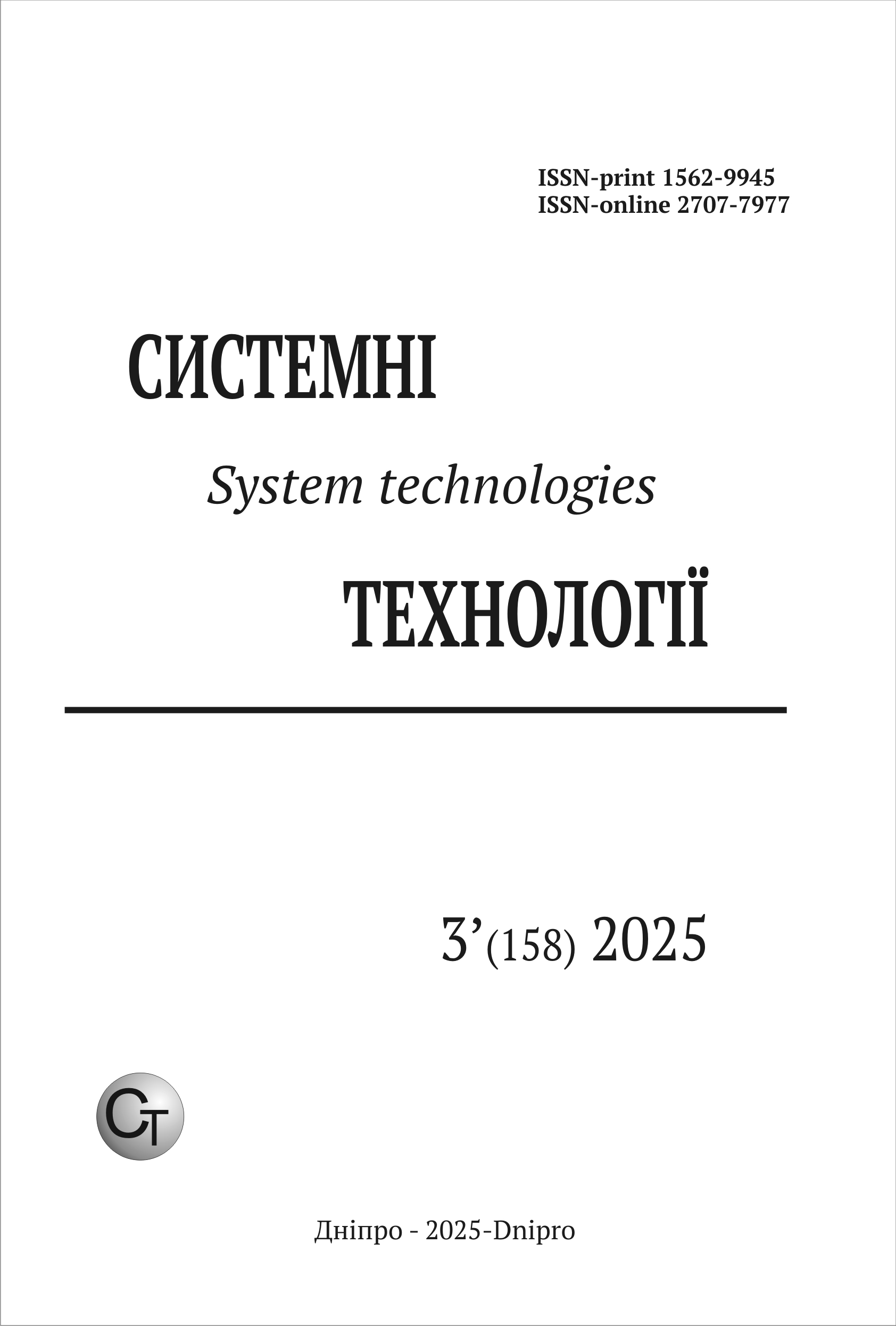CLASSIFICATION OF EYE STATE BASED ON EEG DATA USING RECURRENCE ANALYSIS
DOI:
https://doi.org/10.34185/1562-9945-3-158-2025-07Keywords:
EEG classification, open and closed eyes, recurrence analysis, recurrence plots, chaos theory, brain rhythms, phase space, spectral analysis, SVM, determinism.Abstract
The relevance of this study is driven by the growing interest in portable EEG devices and the need to develop efficient algorithms for analyzing brain activity with limited technical resources. This paper addresses the problem of classifying brain states based on elec-troencephalography (EEG) data to distinguish between two specific states: relaxation and concentration. The classification of open and closed eyes is examined, as eye closure is asso-ciated with increased relaxation. A classification method based on the quantitative analysis of recurrence plots, which is one of the approaches of chaos theory, is proposed and compared with traditional brain rhythm analysis. Experimental results showed that the recurrence anal-ysis method outperforms spectral analysis in classification accuracy, particularly for the O1 point, where accuracy increased from 86% to 95%. The optimal parameters for phase space reconstruction were determined: delay 25 ms and dimension of the embedding space 4, which are consistent with the spectral characteristics of the signal. Feature importance analysis re-vealed that the most significant parameters for classification are entropy, the length of white vertical and diagonal lines in recurrence plots, as well as determinism and laminarity. The obtained results may be useful for developing EEG analysis algorithms in portable devices and applications in the fields of brain-computer interfaces and cognitive training.
References
Muse™ EEG-Powered Meditation & Sleep Headband. (n.d.). Retrieved April 1, 2025, from https://choosemuse.com/
Ye. S. Panasenko, & V. Ye. Belozyorov. (2024). THE APPLICATION OF SPECTRAL ANALYSIS OF EEG DATA FOR THE IDENTIFICATION OF OPEN AND CLOSED EYE STATES. System Technologies, 6(155, 155), 101–115. https://doi.org/10.34185/1562-9945-6-155-2024-11
Kargarnovin, S., Hernandez, C., Farahani, F. V., & Karwowski, W. (2023). Evidence of Chaos in Electroencephalogram Signatures of Human Performance: A Systematic Review. Brain Sciences, 13(5), 813. https://doi.org/10.3390/brainsci13050813
Mohanchandra, K., Saha, S., & Murthy, K. S. (2016). Evidence of Chaos in EEG Signals: An Application to BCI. In A. T. Azar & S. Vaidyanathan (Eds.), Advances in Chaos Theory and Intelligent Control (pp. 609–625). Springer International Publishing. https://doi.org/10.1007/978-3-319-30340-6_25
Wang, X., Meng, J., Tan, G., & Zou, L. (2010). Research on the relation of EEG signal chaos characteristics with high-level intelligence activity of human brain. Nonlinear Biomedi-cal Physics, 4(1), 2. https://doi.org/10.1186/1753-4631-4-2
Furman, Ł., Duch, W., Minati, L., & Tołpa, K. (2023). Short-time Fourier transform and embedding method for recurrence quantification analysis of EEG time series. The European Physical Journal Special Topics, 232(1), 135–149. https://doi.org/10.1140/epjs/s11734-022-00683-7
Garcia-Rill, E., D’Onofrio, S., Luster, B., Mahaffey, S., Urbano, F. J., & Phillips, C. (2016). The 10 Hz Frequency: A Fulcrum For Transitional Brain States. Translational Brain Rhythmicity, 1(1), 7–13. https://www.ncbi.nlm.nih.gov/pmc/articles/PMC4990355/
EEG Motor Movement/Imagery Dataset. (n.d.). Retrieved February 21, 2024, from https://archive.physionet.org/pn4/eegmmidb/
Schalk, G., McFarland, D. J., Hinterberger, T., Birbaumer, N., & Wolpaw, J. R. (2004). BCI2000: A general-purpose brain-computer interface (BCI) system. IEEE Transactions on Bio-Medical Engineering, 51(6), 1034–1043. https://doi.org/10.1109/TBME.2004.827072
Goldberger, A. L., Amaral, L. A., Glass, L., Hausdorff, J. M., Ivanov, P. C., Mark, R. G., Mietus, J. E., Moody, G. B., Peng, C. K., & Stanley, H. E. (2000). PhysioBank, PhysioTool-kit, and PhysioNet: Components of a new research resource for complex physiologic signals. Circulation, 101(23), E215–220. https://doi.org/10.1161/01.cir.101.23.e215
Rolink, J., Kutz, M., Fonseca, P., Long, X., Misgeld, B., & Leonhardt, S. (2015). Recur-rence quantification analysis across sleep stages. Biomedical Signal Processing and Control, 20, 107–116. https://doi.org/10.1016/j.bspc.2015.04.006
Joab R Winkler. (1993). Numerical recipes in C: The art of scientific computing, second edition. Endeavour, 17(4), 554. https://doi.org/10.1016/0160-9327(93)90069-F
Chelidze, T., & Matcharashvili, T. (2015). Dynamical Patterns in Seismology. In Jr. Web-ber Charles L. & N. Marwan (Eds.), Recurrence Quantification Analysis: Theory and Best Practices (pp. 291–334). Springer International Publishing. https://doi.org/10.1007/978-3-319-07155-8_10
Webber, C. L. (n.d.). Chapter 2. Recurrence Quantification Analysis of Nonlinear Dy-namical Systems.
Myers, A., & Khasawneh, F. A. (2020). On the automatic parameter selection for permu-tation entropy. Chaos: An Interdisciplinary Journal of Nonlinear Science, 30(3), 033130. https://doi.org/10.1063/1.5111719
Time Series Analysis: Forecasting and Control, 5th Edition | Wiley. (n.d.). Wiley.com. Retrieved March 16, 2025, from https://www.wiley.com/en-us/Time+Series+Analysis%3A+Forecasting+and+Control%2C+5th+Edition-p-9781118675021
Khasawneh, F. A., Munch, E., Barnes, D., Chumley, M. M., Güzel, İ., Myers, A. D., Tanweer, S., Tymochko, S., & Yesilli, M. (2025). Teaspoon: A Python Package for Topologi-cal Signal Processing. Journal of Open Source Software, 10(107), 7243. https://doi.org/10.21105/joss.07243
Rawald, T., Sips, M., & Marwan, N. (2017). PyRQA—Conducting recurrence quantifica-tion analysis on very long time series efficiently. Computers & Geosciences, 104, 101–108. https://doi.org/10.1016/j.cageo.2016.11.016
Rawald, T., Sips, M., Marwan, N., & Dransch, D. (2014). Fast Computation of Recur-rences in Long Time Series. In N. Marwan, M. Riley, A. Giuliani, & Jr. Webber Charles L. (Eds.), Translational Recurrences (pp. 17–29). Springer International Publishing. https://doi.org/10.1007/978-3-319-09531-8_2
Chang, C.-C., & Lin, C.-J. (2011). LIBSVM: A library for support vector machines. ACM Transactions on Intelligent Systems and Technology, 2(3), 1–27. https://doi.org/10.1145/1961189.1961199
SVC. (n.d.). scikit-learn. Retrieved March 16, 2025, from https://scikit-learn.org/stable/modules/generated/sklearn.svm.SVC.html
V. Ye. Belozyorov. (2018). On novel conditions of chaotic attractors existence in autono-mous polynomial dynamical systems. Nonlinear Dynamics, 91(4), 2435–2452. https://doi.org/10.1007/s11071-017-4023-y
Downloads
Published
Issue
Section
License
Copyright (c) 2025 System technologies

This work is licensed under a Creative Commons Attribution 4.0 International License.















